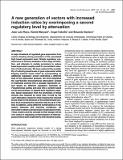Por favor, use este identificador para citar o enlazar a este item:
http://hdl.handle.net/10261/40433COMPARTIR / EXPORTAR:
 SHARE SHARE
 CORE
BASE CORE
BASE
|
|
| Visualizar otros formatos: MARC | Dublin Core | RDF | ORE | MODS | METS | DIDL | DATACITE | |

| Título: | A new generation of vectors with increased induction ratios by overimposing a second regulatory level by attenuation |
Autor: | Royo, José Luis CSIC ORCID; Manyani, Hamid; Cebolla, Ángel; Santero, Eduardo CSIC ORCID | Palabras clave: | Bacterial proteins DNA-binding proteins Gene expression regulation Klebsiella oxytoca Operon Pseudomonas putida RNA- binding Trans-activators Transcription factors XylS protein Pseudomonas putida Antiterminator proteins |
Fecha de publicación: | 31-oct-2005 | Editor: | Oxford University Press | Citación: | Nucleic Acids Research 33(19): e169 (2005) | Resumen: | A major drawback of regulated gene expression from vectors bearing strong promoters is the associated high basal expression level. Simple regulatory systems have an intrinsic limitation in the range of induction, and attempts to mutate promoters to reduce basal expression usually result in concomitant reduction of induced levels. We have explored the possibility of reducing basal levels of gene expression while keeping induced levels intact by incorporating an additional regulatory circuit controlling a different step of the expression process. We have integrated the nasFEDCBA transcriptional attenuation system of Klebsiella oxytoca into a cascade expression circuit based on different regulatory elements of Pseudomonas putida, and also into a system based on the tac promoter, to expand their regulatory capacity. Basal expression from the promoters of these circuits was reduced by more than 10-fold by the nasF attenuator sequence while keeping the induced levels intact in the presence of the antiterminator protein, thus increasing the induction ratio by up to 1700-fold. In addition, using different combinations of regulatory elements and inducing conditions, we were able to obtain a broad range of expression levels. These vectors and the concept of their design will be very useful in regulating overproduction of heterologous proteins both at laboratory and industrial scales. | Descripción: | 10 páginas, 3 figuras, 2 tablas. | Versión del editor: | http://dx.doi.org/10.1093/nar/gni168 | URI: | http://hdl.handle.net/10261/40433 | DOI: | 10.1093/nar/gni168 | ISSN: | 1362-1048 | E-ISSN: | 1362-4962 |
| Aparece en las colecciones: | (CABD) Artículos |
Ficheros en este ítem:
| Fichero | Descripción | Tamaño | Formato | |
|---|---|---|---|---|
| Generation_2005.pdf | 304,15 kB | Adobe PDF |  Visualizar/Abrir |
CORE Recommender
PubMed Central
Citations
6
checked on 19-abr-2024
SCOPUSTM
Citations
10
checked on 15-abr-2024
WEB OF SCIENCETM
Citations
7
checked on 24-feb-2024
Page view(s)
310
checked on 18-abr-2024
Download(s)
250
checked on 18-abr-2024
Google ScholarTM
Check
Altmetric
Altmetric
Artículos relacionados:
NOTA: Los ítems de Digital.CSIC están protegidos por copyright, con todos los derechos reservados, a menos que se indique lo contrario.
